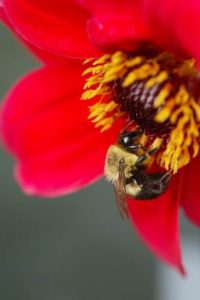01
Aug
Suburban Bees Still Vulnerable to Neonicotinoids Despite EU Ban
 (Beyond Pesticides, August 1, 2018) According to new research from the University of Sussex, bees living in suburban habitats are still being exposed to high levels of neonicotinoid pesticides. Even though there is a European Union (EU) ban on these chemicals, the ban focuses on agricultural and not residential applications. The study’s authors are urging gardeners to forgo the use of these pesticides in favor of more holistic, pesticide-free approaches.
(Beyond Pesticides, August 1, 2018) According to new research from the University of Sussex, bees living in suburban habitats are still being exposed to high levels of neonicotinoid pesticides. Even though there is a European Union (EU) ban on these chemicals, the ban focuses on agricultural and not residential applications. The study’s authors are urging gardeners to forgo the use of these pesticides in favor of more holistic, pesticide-free approaches.
The authors of the study say it is the first of its kind to highlight the risk to bees in urban areas posed by garden use of pesticides. Entitled Monitoring neonicotinoid exposure for bees in rural and peri-urban areas of the UK during the transition from pre- to post-moratorium, the study sampled pollen and nectar from bumblebee colonies in rural and peri-urban habitats in three UK regions–Stirlingshire, Hertfordshire, and Sussex over three years. Sampling began prior to the ban (2013), during the initial implementation when some seed-treated winter-sown oilseed rape was still grown (2014), and following the ban (2015). Honey bee colonies in rural habitats were also sampled to compare species-level differences between bumblebees and honey bees.
Not surprisingly, the researchers find pesticide contamination in more than 50 percent of the samples, with thiamethoxam detected at the highest concentration in honey bee and bumblebee-collected pollen and nectar. For the 2014 sample period, honey bees were exposed to higher levels of neonicotinoids than bumblebees. Imidacloprid and thiacloprid were also found in samples. Check out the Seeds that Poison video.
Results found that, in general, neonicotinoid exposure for rural (typically agricultural areas) bees declined post-ban (2015), but that bees in suburban environments remain at risk of high levels of neonicotinoid exposures. For imidacloprid, the researchers believe that continued contamination could also be due to pet flea treatments, which still often contain this chemical. In addition to pesticide garden products, contaminated ornamental plants sold in garden centers play a key role in spreading neonicotinoids through suburban areas, the researchers note. A previous study, also at the University of Sussex, revealed that 70% of bee-friendly plants sold at a range of garden centers had traces of neonicotinoids. Researchers are now urging suburban gardeners to get rid of their bug sprays immediately in favor of encouraging natural predators like ladybirds or lacewings, and the use of physical methods such as hand-removal of pests, and netting or sticky traps.
“Our findings suggest that the EU’s recent decision to extend the neonicotinoid moratorium to include all field crops is likely to have a positive effect on bees, relieving some of the stress on our already struggling pollinator populations. However, given that bees in suburban gardens appear to remain at risk post-moratorium, further work is needed to understand the sources of neonicotinoid exposure in these areas and to find ways to reduce it. Our study indicates that limiting the public sale and use of neonicotinoid-based bug sprays, which are currently unaffected by the moratorium, is needed if we are to protect bee populations living in and around our towns and cities,” said Beth Nicholls, PhD, postdoctoral research fellow in evolution, behaviour and environment at the University of Sussex and the study’s lead author.
In 2013, the European Commission instituted an EU-wide moratorium on the use of three types of neonicotinoid (thiamethoxam, clothianidin, and imidacloprid) on bee-attractive flowering crops, such as oilseed rape. The ban will be expanded to include all field crops in 2019. According to the European Commission, protection of bees is an important issue, since it concerns biodiversity, food production, and the environment. An EU committee approved the plan to tighten and expand restrictions on the use of the neonicotinoid pesticides, acting upon scientific advice this past February from the European Food Safety Authority (EFSA) to tighten existing restrictions and protect bees, crucial pollinators. EFSA analyzed over 1,500 studies from academia, beekeeper associations, chemical companies, farmer groups, non-governmental organizations, and national regulators, and concluded that neonicotinoids pose risks to honey bees and wild pollinators.
The U.S. Environmental Protection Agency (EPA) is currently reviewing public comments on its preliminary ecological and human health risk assessments for the neonicotinoids clothianidin, thiamethoxam and dinotefuran, and a preliminary ecological risk assessment for the neonicotinoid imidacloprid. EPA’s risk assessments find deadly impacts to birds from neonicotinoid-treated seeds, poisoned insect prey, and contaminated grasses. Researchers have found that tiny amounts of neonicotinoids are enough to cause migrating songbirds to lose their sense of direction. A recent study by U.S. Geological Survey (USGS) researchers found neonicotinoids widespread in the Great Lakes at levels that harm aquatic insects, and potentially the aquatic food web—the foundation of healthy aquatic ecosystems.
One recent study finds that bumblebee queens that wake up from hibernation to a neonicotinoid-contaminated, monofloral landscape take longer to set up their nest and die-off at higher rates. Previous studies have indeed found neonicotinoids to be associated with altered feeding behaviors and reduced egg development in bumblebee queens, as well as the inhibition of pollination skills among bumblebee workers, the loss of bumblebees’ characteristic “buzz” pollination technique, and reductions in overall colony size. For more, visit the What the Science Shows page.
Take Action: Urge your U.S. Representative to support the Saving America’s Pollinators Act. With managed honey bee losses remaining at unsustainable levels and many wild pollinators at risk of extinction, it’s time, for the future of food and our environment, for the U.S. to finally protect pollinators.
All unattributed positions and opinions in this piece are those of Beyond Pesticides.
Source: Science Daily










